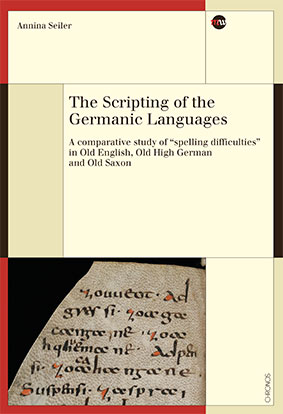- Kurztext
- Autor/in
- Einblick
- Buchreihe
- Downloads
The early medieval Germanic languages started to be written down in the Roman alphabet when their speakers converted to Christianity and adopted parts of Late Antique culture. For the West Germanic dialects spoken in England and on the Continent, this process took place essentially from the late 7th to the early 9th century. The scripting of these languages included the transfer and adaptation of the alphabet to the vernacular languages. Some of the specifically Germanic sounds caused spelling problems since there were no characters available for them in the Roman alphabet. The analysed data reveal surprisingly sophisticated spellings, demonstrating both a high degree of phonological awareness as well as an intimate knowledge of Latin orthography on the part of the writers. The study demonstrates that these early writing systems, though highly idiosyncratic, are more regular than has previously been known: The first writers of German and English follow the orthographic rules that they set up for themselves with unexpected consistency.
Inhalt
THE SCRIPTING OF THE GERMANIC LANGUAGES
From spoken to written word
The scripting of West Germanic
West Frankish
Old English
Old High German
Old Saxon
Corpus of the present study
Old English sources
Early Anglo-Saxon charters
The Épinal glossary
The Old English material in Bede’s Ecclesiastical History
Later Old English sources
Old High German sources
Early Old High German glosses
Vocabularius Sti Galli
Part Ka of the Old High German Abrogans glossary
OHG Isidore translation
Later Old High German sources
Old Saxon sources
Old Saxon Creed
Later Old Saxon sources
Spelling problems
The consonants of the West Germanic languages
Scripting with the Latin alphabet
HISTORICAL GRAPHEMICS
Methodological problems of graphemic research
“Deficiencies” of writing
The reading process
Circular reasoning
Phonographic and morphographic
Method and terminology
The concept of the sound position
Characters, graphs and graphemes
Quantification and the concept of the leading graph
Some methodological consequences and problems
GRAPHEMIC ANALYSIS I: MISSING LETTERS
Outline
Gmc. */w/ in OE, OHG, OS
Phonology
Sound positions
Old English
Old High German
Old Saxon
Summary and conclusions
Gmc. */þ/ in OE, OHG, OS
Phonology
Sound positions
Old English
Old High German
Old Saxon
Summary and conclusions
Gmc. */χ/ in OE, OS, OHG and Gmc. */k/ in OHG
Phonology
Sound positions
Old English
Old High German
Old Saxon
Summary and conclusions
Gmc. */ƀ/ in OE, OS, OCFr
Phonology
Sound positions
Old English
Old Saxon
Summary and conclusions
Spellings for OHG /tz/ and /zz/ (< Gmc. */t/)
Phonology
Sound positions
Old High German
Summary and conclusions
GRAPHEMIC ANALYSIS II: “SUPERFLUOUS” LETTERS
Outline
The letter k
The letter q
The letter x
The letter z
Summary and conclusion
RESULTS
Towards a history of spelling
Old English
Overview
Contextualisation of analysed texts
Old High German
Overview
Contextualisation of analysed texts
Old Saxon
Summary and conclusion
Variability of early medieval scripts
Measures of variability and consistency
Consistency and the identification of leading graphs
Summary and conclusion
From spoken to written word
The scripting of West Germanic
West Frankish
Old English
Old High German
Old Saxon
Corpus of the present study
Old English sources
Early Anglo-Saxon charters
The Épinal glossary
The Old English material in Bede’s Ecclesiastical History
Later Old English sources
Old High German sources
Early Old High German glosses
Vocabularius Sti Galli
Part Ka of the Old High German Abrogans glossary
OHG Isidore translation
Later Old High German sources
Old Saxon sources
Old Saxon Creed
Later Old Saxon sources
Spelling problems
The consonants of the West Germanic languages
Scripting with the Latin alphabet
HISTORICAL GRAPHEMICS
Methodological problems of graphemic research
“Deficiencies” of writing
The reading process
Circular reasoning
Phonographic and morphographic
Method and terminology
The concept of the sound position
Characters, graphs and graphemes
Quantification and the concept of the leading graph
Some methodological consequences and problems
GRAPHEMIC ANALYSIS I: MISSING LETTERS
Outline
Gmc. */w/ in OE, OHG, OS
Phonology
Sound positions
Old English
Old High German
Old Saxon
Summary and conclusions
Gmc. */þ/ in OE, OHG, OS
Phonology
Sound positions
Old English
Old High German
Old Saxon
Summary and conclusions
Gmc. */χ/ in OE, OS, OHG and Gmc. */k/ in OHG
Phonology
Sound positions
Old English
Old High German
Old Saxon
Summary and conclusions
Gmc. */ƀ/ in OE, OS, OCFr
Phonology
Sound positions
Old English
Old Saxon
Summary and conclusions
Spellings for OHG /tz/ and /zz/ (< Gmc. */t/)
Phonology
Sound positions
Old High German
Summary and conclusions
GRAPHEMIC ANALYSIS II: “SUPERFLUOUS” LETTERS
Outline
The letter k
The letter q
The letter x
The letter z
Summary and conclusion
RESULTS
Towards a history of spelling
Old English
Overview
Contextualisation of analysed texts
Old High German
Overview
Contextualisation of analysed texts
Old Saxon
Summary and conclusion
Variability of early medieval scripts
Measures of variability and consistency
Consistency and the identification of leading graphs
Summary and conclusion
Diese Buchreihe vereinigt Studien des gleichnamigen Nationalen Forschungsschwerpunkts sowie mediengeschichtliche Arbeiten. Sie rückt die Zeit vor der Ausbreitung der Massenmedien und insbesondere die medialen Verhältnisse der Vormoderne ins Zentrum. Damit ermöglicht sie Einblicke in die Andersartigkeit älterer Kommunikationsformen und erlaubt es gleichzeitig, Voraussetzungen für die mediale Formierung der Neuzeit zu ergründen.
